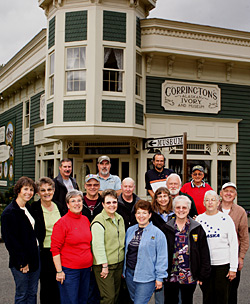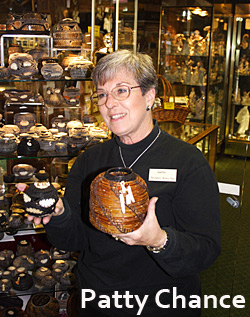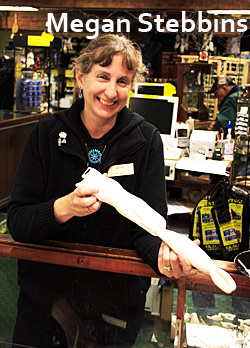The new version of Workamper.com is...
Read moreWorkamping Built on Tourist Trade
Workamping Built on Tourist Trade
Skagway, Alaska is a shopper’s mecca. From mid-May to mid-September, the town of 845 residents swells on summer days to 9,000 people. From cruise ships docked in the harbor at the head of Lynn Canal 90 miles north of Juneau, tourists stroll the streets preserved from the 1897 Gold Rush.
 The only gold mined in Skagway came from the miners’ pockets as they bought grubstakes before heading over the Chilkoot Pass or the White Pass Trail to seek their fortunes in Canada’s Klondike Gold Fields. Today, Skagway thrives on the ambience of those wild and wooly days, preserved by the Klondike Gold Rush National Historical Park in its headquarters and numerous other restored buildings. The historical town’s economy depends on tourists purchasing jewelry, clothing, and artwork displayed in false-fronted shops along nostalgic boardwalks.
The only gold mined in Skagway came from the miners’ pockets as they bought grubstakes before heading over the Chilkoot Pass or the White Pass Trail to seek their fortunes in Canada’s Klondike Gold Fields. Today, Skagway thrives on the ambience of those wild and wooly days, preserved by the Klondike Gold Rush National Historical Park in its headquarters and numerous other restored buildings. The historical town’s economy depends on tourists purchasing jewelry, clothing, and artwork displayed in false-fronted shops along nostalgic boardwalks.
High-dollar shopping in any tourist destination opens up jobs for Workampers. Skagway is no exception. Corrington Enterprises, a business owned by Dennis and Nancy Corrington, stands in the center of the business district in five separate locations. In the 2006 season, 21 Workamping couples, half of them returnees, staffed Corrington’s initial store, Alaska Ivory; Skagway Outlet, the original outlet store for Southeast Alaska; Skagway Brewing Company; Skagway Bazaar Passage, a drop ship store in the corridor of one of the company’s buildings; and a Close-Out Store in the same building.
In recruiting Workampers, general manager Jerry Epps looks for people who are willing to make a commitment to Corrington Enterprises for five months. “It doesn’t happen often, but if people agree to work, but do not stay, the company is in a bind for employees,” he says. “Drawing from Skagway’s population, an available workforce is slim.”
Although Epps says he does not necessarily seek employees with retail experience, he notes that most workers end up doing retail—at least part of the time. “We can train anyone to run a cash register,” he continues. “We have a couple of women who work in the office, but they also work in the retail shops. We also hire people for warehouse work and for maintenance, but the majority of our Workampers are in our stores, catering to customers daily.”
Jeanette Fulton is one of those with no retail experience. She and her husband, Bob, took their first Workamping job with Corrington Enterprises after 15 years of retirement.
Jeanette admits her apprehension. “At age 67, I didn’t know if I could return to work and learn how to use a computerized cash register. Now, my coworkers affectionately call me ‘the old lady,’ but I can work circles around some of the younger employees.”
 According to Epps, Workampers arrive in mid-April and help to stock and set up the stores for the cruise ship season, which begins about May 10. By the end of September, all employees are gone, except for a couple in maintenance, who stay to winterize the buildings. By October 5, management, too, returns to the Lower 48. Corrington starts first season Workampers at $10 an hour, Epps says. However, he notes that $2 of that wage is reserved for an end of the season bonus for those who fulfill their commitment. “I make it clear that the company does not pay anyone the bonus unless they complete the agreed upon commitment, no matter the reason they have to leave.”
According to Epps, Workampers arrive in mid-April and help to stock and set up the stores for the cruise ship season, which begins about May 10. By the end of September, all employees are gone, except for a couple in maintenance, who stay to winterize the buildings. By October 5, management, too, returns to the Lower 48. Corrington starts first season Workampers at $10 an hour, Epps says. However, he notes that $2 of that wage is reserved for an end of the season bonus for those who fulfill their commitment. “I make it clear that the company does not pay anyone the bonus unless they complete the agreed upon commitment, no matter the reason they have to leave.”
Workampers put in 40-hour workweeks. “Sometimes early in the season, I cannot give everybody 40 hours of work—unless they want to do extra outside jobs such as painting or landscaping,” Epps says. “For instance, in 2006, our inventory did not arrive on schedule and we had nothing to stock in the stores. For about two weeks, the Workampers only had 32 hours per week. However, I believe that at least half of our Workampers come for the experience, rather than the income.”
He adds that Skagway offers hiking, fishing, and kayaking for people who love the outdoors. “I tell applicants there are no malls, no McDonalds, no Wal-Marts, and no movie theaters in Skagway,” he says. “However, there are many tours, such as helicopter and sea tours, and the White Pass & Yukon train trip to Whitehorse and back. Early in the season, those companies often offer discounted tickets as they train new people.”
Corrington’s Workampers have two days off each week and some make the four-hour round trip to Whitehorse, Yukon, to shop, go to a movie, and indulge in a fast-food restaurant. Additionally, Epps points out that Workampers can order food from Costco in Juneau and have it arrive on a supply barge.
“I also tell applicants that prices, including fuel and food, are generally ten percent higher in Skagway than in the lower 48 states,” Epps continues. “Everything has to arrive at Skagway on a barge."
Jim and Megan Stebbins are one example of couples returning to Corrington for third and fourth seasons. Generally, Megan works with other Workampers at the Corrington Ivory Store.
“The town is crazy Monday through Thursday,” she says. “Then it slows down for the weekend. But the busyness adds a nice rhythm to the week."
“Oh, sure, we whine about the weather at times, which is generally cool and often wet,” she says with a laugh. “The name Skagway, originally spelled Skaguay, is a Tglinket word in native dialect meaning ‘stiffly wind rippled water.’ That should give a clue that the wind blows up the Lynn Canal straight onto Skagway’s streets.”
Patty Chance, a former ER nurse, has also worked at the Corrington Ivory Store for three seasons. “I fell in love with the artful weaving of whale baleen into baskets by Sheri Ables, an Alaskan artist with Aleut heritage,” Patty says. “One season, my enthusiasm helped me sell 88 of the baskets with starting prices at $200.”
Patty adds that management never looks over their shoulder and work time is relaxed and interesting. She goes on to say there is much to learn about the artists and their work displayed in the store.
“When I started, I didn’t know plastic from ivory!” she states. “My co-worker, Mark Springan, helped me with information about the ivory handled knives on which artists do crimshaw. I also learned from the customers. If a man came in to look at knives, most likely, he knew something about them. So I listened.”
 Although many of the Workampers work at different times in other shops, Eric Steilberger laughingly says he is most suited for the cold air that flows down the hallway store, Skagway Bazaar Passage. The corridor walls, leading off the street into a courtyard surrounded by other shops, display artwork and chiming clocks set in Swarvorski crystal.
Although many of the Workampers work at different times in other shops, Eric Steilberger laughingly says he is most suited for the cold air that flows down the hallway store, Skagway Bazaar Passage. The corridor walls, leading off the street into a courtyard surrounded by other shops, display artwork and chiming clocks set in Swarvorski crystal.
Jim Stebbins often clerks at Skagway Brewry, a shop that also displays fine Alaskan artwork. Yet, he switches with Eric and takes a turn in the windy corridor store. While some couples like Eric and Denise and Jim and Megan work in different locations, others like Mike and Donna Oliverio work together at the Skagway Outlet Store.
Corrington’s Workampers live in a private 22-space RV park located on their warehouse property alongside the rushing Skagway River. In the spring, Workampers arrive to heavy snow on the tall mountains rising on either side of the park situated in a narrow valley. Often, they see wildlife on the mountainsides. One summer, a bear with two cubs ambled in and out between their rigs.
A full hookup 50-amp site is part of Corrington’s benefit package. Each couple is charged $100 a month for utilities, which the company subsidizes.
“The company improves the park each year,” Epps says. “They built a clubhouse with a spacious deck along one side of the warehouse for potlucks, card parties, and any other Workamper get-togethers. At least twice during the season, Corrington hosts a party for its employees. In 2006, we added a greenhouse for the Workampers to grow their vegetables.”
The Workampers are a tight knit group, enjoying each other’s company. Patty Chance says, “Living in this park, I feel like I’m at Girl Scout Camp every summer! We’re like family here. Whatever complimentary anyone can say about Corrington Enterprises as employers, I would triple it.”


